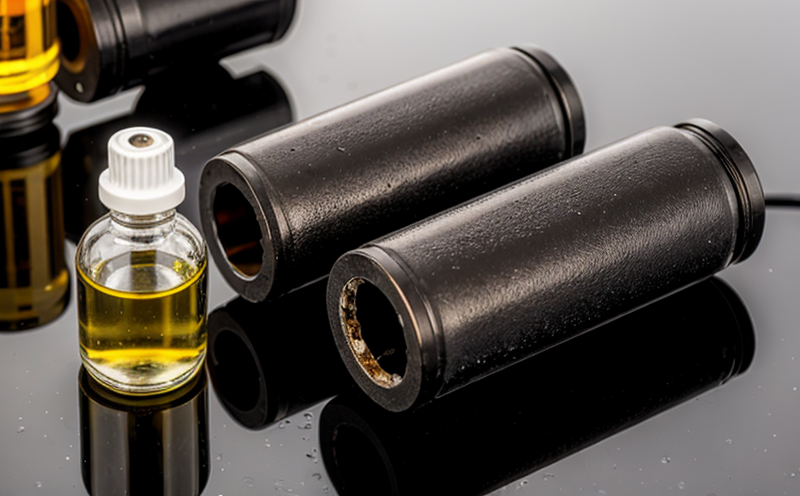ASTM D7679 Marine Diesel Oil Hydrocarbons Test in Water
The ASTM D7679 test method is specifically designed to determine hydrocarbon levels present in water samples that have been contaminated by the release of marine diesel oil. This service ensures compliance with environmental regulations and supports decision-making processes for pollution control, remediation efforts, and quality assurance within the maritime industry.
This testing is critical for ensuring the integrity and safety of aquatic ecosystems affected by accidental or operational discharges from vessels and port activities. The methodology involves collecting a representative sample of water, extracting hydrocarbons using organic solvents like hexane, and quantifying them via gas chromatography (GC). Compliance with ASTM D7679 is essential for maintaining regulatory standards set forth by agencies such as the Environmental Protection Agency (EPA) in the U.S. and comparable bodies internationally.
Understanding the specific application of this standard helps stakeholders appreciate its significance:
- Environmental impact assessment
- Emergency response planning
- Regulatory compliance verification
- Operational best practices implementation
The ASTM D7679 procedure provides a robust framework for quantifying hydrocarbon contamination, offering detailed steps for sample collection and preparation. This ensures that all participants in the testing process adhere to consistent protocols, leading to reliable results.
| Step | Action |
|---|---|
| 1 | Collect a minimum of 250 mL of water from the sampling location using a sterile container. |
| 2 | Transfer the sample to a suitable vial and add an internal standard. |
| 3 | Extract hydrocarbons by shaking vigorously with hexane. |
| 4 | Separate phases using centrifugation or filtration if necessary. |
| 5 | Determine concentrations of individual components through GC analysis. |
By following these steps meticulously, laboratories can provide accurate and reliable data that informs critical decisions regarding environmental protection and resource management. Compliance with ASTM D7679 is not only a legal requirement but also a key factor in maintaining the credibility of test results within regulatory circles.
The precision and accuracy of hydrocarbon analysis are paramount when dealing with complex mixtures found in marine environments. Understanding the nuances of this testing process allows for better interpretation of data, which can lead to more effective mitigation strategies and improved overall environmental quality.
Applied Standards
The ASTM D7679 test method is widely recognized and utilized in various sectors including marine transportation, port authorities, and environmental agencies. Its application ensures consistency across different regions and organizations, facilitating interoperability between stakeholders involved in water quality monitoring.
| Standards | Description |
|---|---|
| ASTM D7679-18 | Standard Practice for Determination of Hydrocarbon Contamination from Marine Diesel Oil Released into Water |
| ISO 15402-3:2004(E) | Environmental Quality—Guidelines for Surface Water—Part 3: Chemical Quality |
| EN ISO 16819:2017 | Water quality—Determination of hydrocarbons by gas chromatography |
The use of these standards ensures that the testing process adheres to internationally accepted practices, thereby enhancing trust and credibility among all parties concerned. Compliance with such standards is crucial for maintaining high-quality data and fostering effective communication between different entities involved in environmental protection efforts.
Benefits
- Enhanced Regulatory Compliance: Ensures adherence to relevant regulations set by local, national, or international bodies.
- Precision and Accuracy: Provides accurate measurements that are essential for making informed decisions.
- Consistent Results: Standardized procedures lead to consistent results across multiple samples and laboratories.
- Informed Decision-Making: Reliable data helps stakeholders prioritize actions based on the severity of contamination.
- Improved Reputation: Demonstrates a commitment to environmental responsibility, which can enhance an organization's reputation.
The benefits extend beyond regulatory compliance; they include improved operational efficiency and reduced risk exposure. By leveraging ASTM D7679 testing services, organizations demonstrate their dedication to sustainable practices and responsible stewardship of natural resources.
Competitive Advantage and Market Impact
The ability to accurately measure hydrocarbon contamination in water samples provides several competitive advantages for organizations operating within the maritime sector. These include:
- Advanced Environmental Monitoring: Leading-edge monitoring capabilities can help firms stay ahead of regulatory changes.
- Customer Trust and Satisfaction: Demonstrating a strong commitment to environmental stewardship builds trust with clients and stakeholders.
- Operational Efficiency: Early detection of contamination allows for swift remediation efforts, minimizing downtime and costs.
- Market Differentiation: Offering comprehensive hydrocarbon testing services positions companies as leaders in environmental compliance and quality assurance.
In a competitive market where regulatory pressures are increasing, having reliable testing services can differentiate an organization from its competitors. This not only enhances its reputation but also opens up new business opportunities by attracting environmentally conscious clients.





